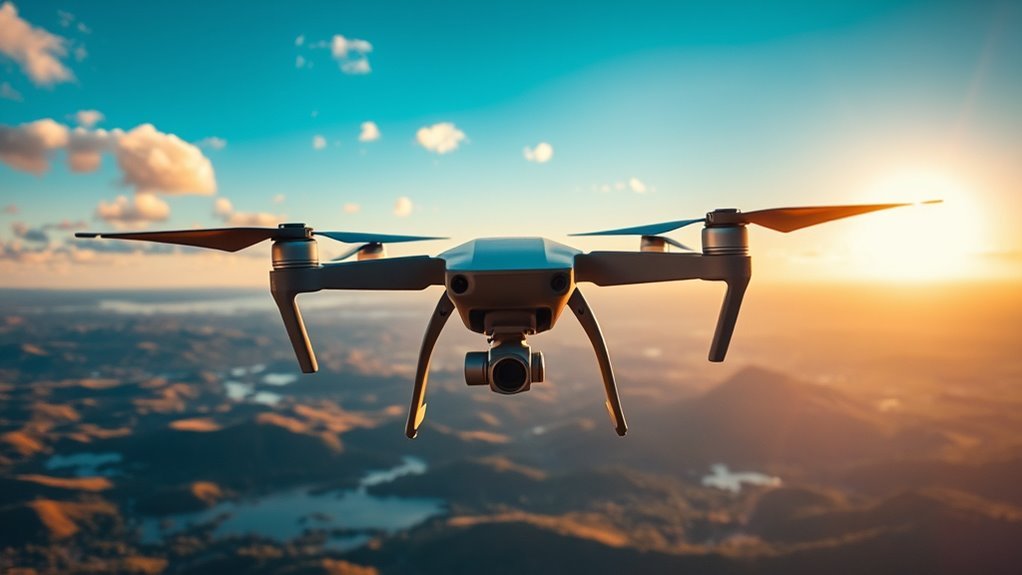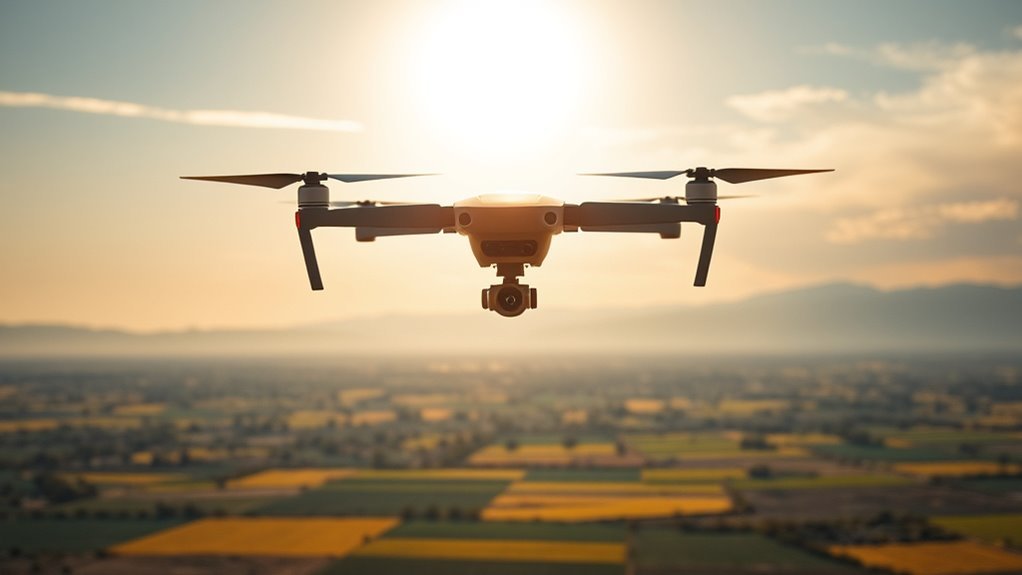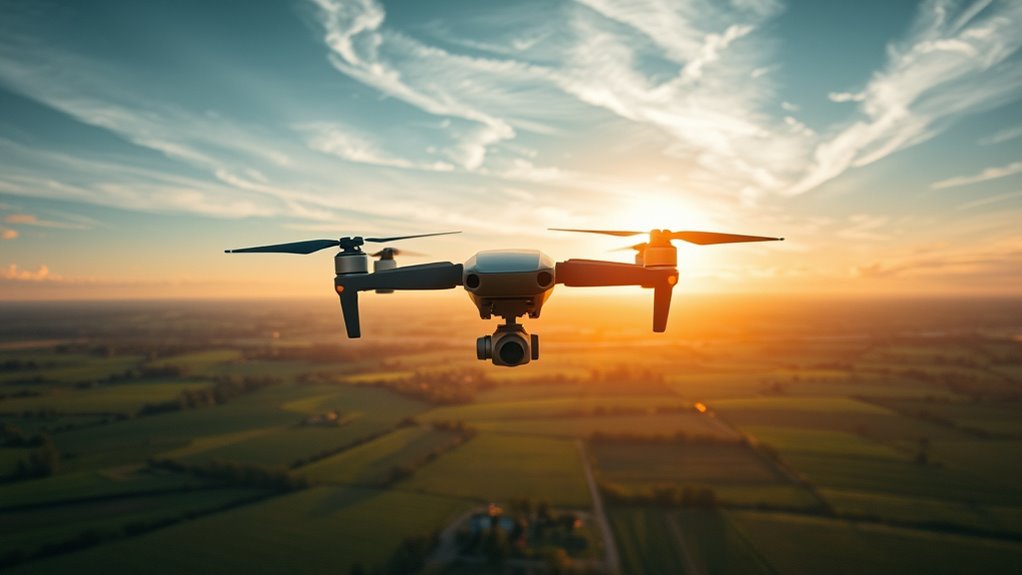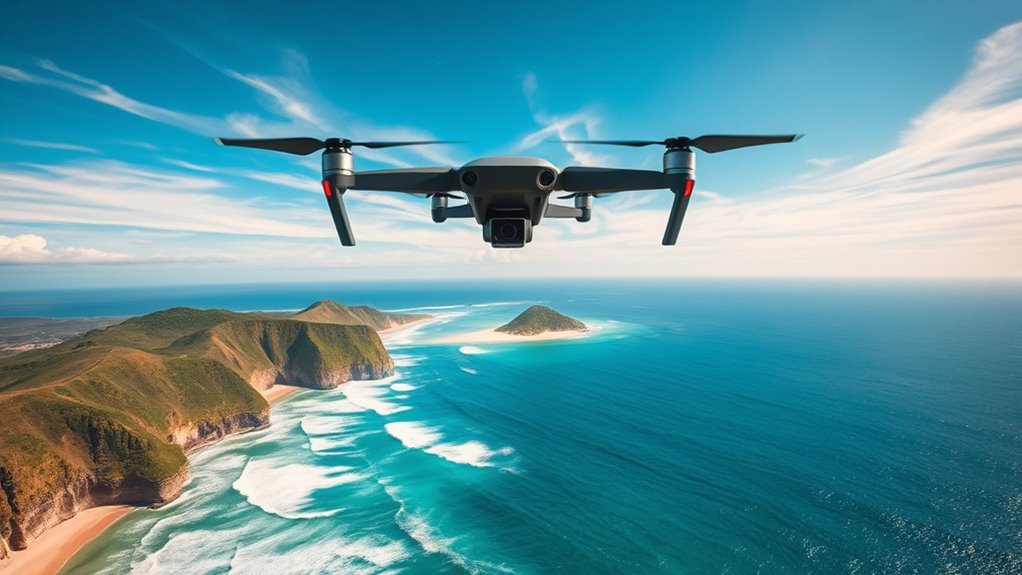Drones can typically fly distances between 1 to 5 kilometers for consumer models and over 10 kilometers for professional types. Range depends on battery capacity, environmental conditions, and signal reliability. Strong winds or heavy precipitation can limit performance, while regulations may restrict flight zones. Understanding these factors is essential to optimizing a drone’s operational range and capabilities. For insights on evolving technologies that expand flight distances, keep exploring this topic further.
Understanding Drone Types and Their Ranges

When considering how far a drone can go, it’s vital to understand the different types of drones and their respective ranges. Each drone type has unique capabilities that dictate its flight distance. For instance, consumer drones typically have a range of 1 to 5 kilometers, while professional models can extend this up to 10 kilometers or more, depending on their range specifications. Advanced communication systems enhance the operational distance in professional drones, allowing them to maintain stable connections even at greater ranges. Racing drones, designed for speed, may prioritize agility over distance, often limiting their range to around 1 kilometer. Understanding these variations allows you to select a drone that aligns with your intended use, whether it’s recreational flying, aerial photography, or surveying. Battery life significantly influences the operational range of drones, making it essential to choose models with optimal power management systems. Knowing the drone capabilities guarantees you maximize your freedom to explore the skies effectively.
Factors Affecting Drone Flight Distance

When considering how far your drone can fly, battery capacity and environmental conditions play essential roles. A higher capacity battery typically extends flight time, while factors like wind speed and temperature can greatly impact performance. Understanding these elements will help you optimize your drone’s range effectively. Additionally, signal range and controller technology are crucial as they determine communication reliability over longer distances. Furthermore, maintaining proper payload distribution can significantly enhance stability and energy efficiency, further extending your drone’s operational range.
Battery Capacity Impact
Battery capacity plays an essential role in determining a drone’s flight distance. Higher-capacity batteries generally provide more energy, enabling extended flights. However, it’s not just about capacity; battery efficiency greatly impacts how that energy translates into actual flight time. Efficient energy management systems optimize power distribution, reducing wastage and maximizing performance. Factors like weight, motor efficiency, and aerodynamics also interact with battery performance to affect overall flight distance. When you select a drone, consider its battery’s specifications alongside its energy management features. This combination guarantees you get the most out of your drone, granting you the freedom to explore further without the constant worry of battery depletion. Ultimately, understanding these elements empowers you to make informed decisions in your aerial adventures.
Environmental Conditions Influence
While battery capacity and efficiency greatly dictate a drone’s flight range, environmental conditions also play a vital role. Weather patterns can considerably impact drone performance. For instance, strong winds can lead to increased energy consumption, reducing your effective flight distance. Rain and snow not only add weight but may also interfere with navigation systems, further constraining range. Meanwhile, terrain features like mountains, forests, or urban structures can create obstacles that require drones to expend more energy to navigate. Understanding these factors is essential for optimizing your flight plans. By considering weather and terrain, you can better strategize your drone’s route, ensuring you maximize its potential distance while maintaining safety and efficiency.
Battery Life and Its Impact on Range

Although many factors influence a drone’s operational range, battery life stands out as a critical determinant. When you’re flying, the capacity and quality of your battery directly impact how far your drone can go. Effective battery maintenance, such as regular checks and proper storage, guarantees peak performance. Additionally, understanding power efficiency can help you maximize flight time. For instance, flying at lower speeds or reducing payload can conserve energy, extending your range. High-quality batteries designed for specific drone models often provide better longevity and reliability. Keep in mind that as battery life diminishes, the drone’s range will also decrease. As a result, prioritizing battery care and choosing efficient flight practices are keys to achieving the freedom you seek in aerial exploration. Notably, the battery capacity of a drone, like the Autel EVO Lite V2’s larger 6,000 mAh, plays a significant role in determining its flight endurance and operational independence. Moreover, understanding discharge rates can help you predict how battery performance affects your flight distance.
Environmental Conditions and Range Limitations
When operating a drone, environmental conditions greatly affect its range. Wind can create resistance that reduces efficiency, while extreme temperatures can impair battery performance and motor function. Understanding these factors is essential for optimizing your drone’s operational distance. Additionally, atmospheric conditions like rain, fog, and dust can degrade signal quality, further impacting the effective flight distance.
Wind Impact on Range
As you navigate the complexities of drone operation, it’s crucial to recognize that wind conditions greatly influence a drone’s effective range. In gusty conditions, wind resistance can considerably degrade flight performance, leading to increased energy consumption and reduced control. When flying against strong winds, your drone may struggle to maintain altitude and speed, resulting in a shorter operational range. Conversely, flying with the wind can extend the range but may complicate return flights. Understanding these dynamics is critical for maximizing your drone’s capabilities. Always check local wind forecasts and plan your routes accordingly to mitigate the adverse effects of wind on your drone’s journey, ensuring a safe and successful flight experience.
Temperature Effects on Performance
Wind isn’t the only environmental factor that affects a drone’s performance; temperature plays a significant role as well. A drone’s temperature sensitivity can impact battery life, motor efficiency, and overall flight range. Here’s how temperature affects your drone:
- Cold temperatures can reduce battery capacity, limiting flight time.
- Hot temperatures may cause overheating, leading to performance throttling.
- Altitude effects amplify temperature fluctuations, impacting lift and stability.
- Rapid temperature changes can affect sensor readings, compromising navigation accuracy.
Understanding these factors helps you plan your flights better. By considering temperature alongside other environmental conditions, you can maximize your drone’s potential and enjoy the freedom of flight with confidence.
Regulatory Restrictions on Drone Flight
While advancements in drone technology have expanded their potential applications, regulatory restrictions greatly influence how far these devices can operate. You must navigate a complex landscape of legal compliance, which includes obtaining flight permissions and adhering to airspace regulations. Different drone classifications come with varying operational zones, impacting your ability to fly freely. Safety guidelines are designed to protect both operators and the public, but they can also limit your range. Additionally, international laws may impose further restrictions if you fly across borders. Enforcement agencies monitor compliance, ensuring that violations can lead to penalties. Understanding these regulations is essential for maximizing your drone’s capabilities while remaining within legal boundaries.
Future Trends in Drone Range Technology
Though current drone technology has made significant strides, the future promises even greater enhancements in range capabilities. As you look forward, consider how advancements will shape the landscape:
Current drone technology is impressive, but the future holds even greater potential for expanding range capabilities and exploring new horizons.
- Advanced propulsion systems will increase efficiency, allowing drones to travel longer distances without sacrificing speed.
- Future materials, such as lightweight composites, will reduce weight and enhance durability, further extending range.
- Battery technologies will evolve, offering longer-lasting power solutions that make extended flights feasible. Additionally, AI tools will optimize flight paths based on real-time data, improving overall efficiency during missions.
- Autonomous navigation advancements will optimize flight paths, maximizing coverage and minimizing energy consumption.
Additionally, advanced camera capabilities will enable drones to capture high-quality visuals from greater distances, enhancing their utility in various applications.
These innovations aren’t just about distance; they’re about the freedom to explore, connect, and utilize drones in ways we’ve yet to imagine. Embrace the future, where the sky’s the limit!
Frequently Asked Questions
Can Drones Fly in Rain or Snow?
When considering flying conditions, it’s essential to know that drones have varying weather durability. While some can handle light rain or snow, others may falter, compromising safety. Always check specifications before taking flight in adverse conditions.
How Do I Extend My Drone’s Flight Range?
To extend your drone’s flight range, consider battery upgrades for longer duration and signal boosters to enhance communication with your device. These modifications greatly improve performance, granting you the freedom to explore further distances.
What Happens if a Drone Loses GPS Signal?
If your drone loses GPS signal, it can struggle with navigation. You’ll need to rely on its inertial sensors for GPS recovery, but this may limit its flight stability and operational range. Always be prepared.
Can Drones Be Used for Delivery Services?
Imagine a bird soaring through the skies; drones can revolutionize delivery services. With drone logistics enhancing delivery efficiency, you’ll experience quicker, more flexible options, freeing you from traditional constraints and transforming how goods reach your doorstep.
Are There Any Weight Limits for Drone Payloads?
Yes, there are weight limits for drone payloads, dictated by drone regulations. These limits vary by model, influencing its payload capacity. Understanding these constraints helps you optimize delivery efficiency while complying with legal requirements.

